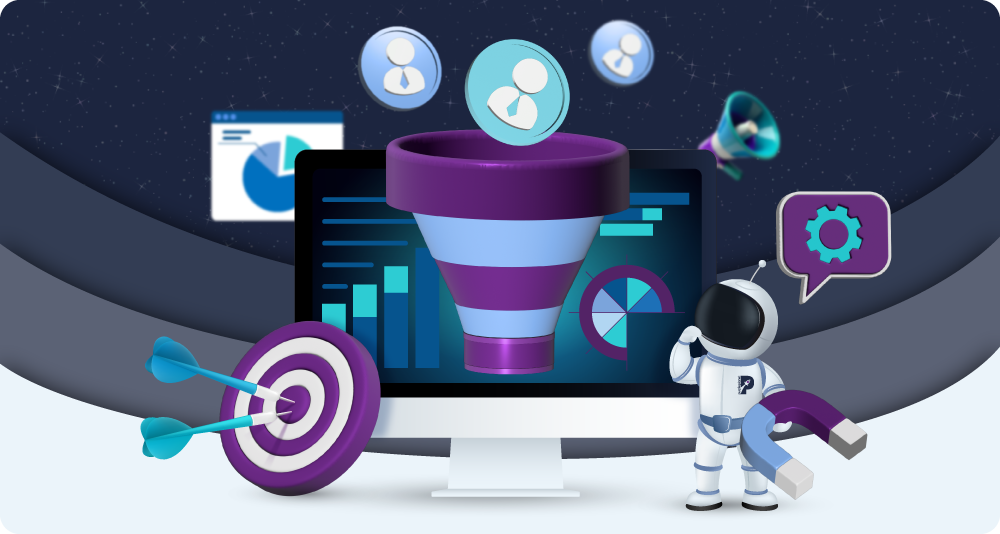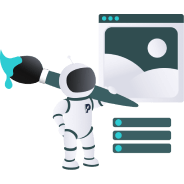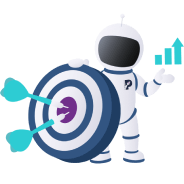

7 Content Types that Drive Lead Generation
Key takeaways
-
Blogs, videos, and email marketing content are the most popular for lead generation efforts.
-
However, content like podcasts and customer success stories can also help generate leads, as long as your business is in the right industry.
-
Whichever content type you choose for your lead generation, automating your efforts will boost your results significantly.
Content makes the world go round, especially in the world of lead generation. Compared to traditional marketing efforts, content will drive 3x as many leads. This blog will explore 7 different types of content and help you decide which is best suited to your business’s lead-generation efforts.
Let’s dive in.
1. Blog posts and articles
The most effective (and unfortunately sometimes the most difficult) form of content marketing is the blog strategy. Blogs top the SEO world too, often being the first advised step when wanting to optimise your website.
It’s not surprising that having a blog is invaluable. In fact, businesses with blogs generate 67% more leads than businesses that don’t. Unfortunately, even a weekly blog strategy is a big investment. Most businesses struggle to finance the rigorous planning and creation needed to publish a high-quality blog. Often businesses will need to outsource freelancers and create content that stands out in an already extremely competitive space.
Nevertheless, blogs remain a powerful channel for lead generation as organic search isn’t letting up.
If you decide it’s time to get started on your very first blog strategy, check out our beginner’s guide to learn the best practices you need to follow. You’ll also do well to create evergreen content, which can keep costs down when you’re just starting off. And finally, read our article about not pursuing every keyword – this can easily trap businesses new to content and SEO and be a big drain on resources.
First of all, is your business even suited to a blog strategy? Some aren’t, and that’s OK. It wouldn’t do to get started and waste resources if another form of content would be better.
Blog strategies are best suited for businesses in content-heavy industries such as digital marketing, health and wellness, finance, lifestyle, and technology. Does your target audience use search engines regularly to learn about your industry? If your ideal customers are likely to look for information that you can provide, an organic blog content strategy is ideal.
Can your business provide valuable, informative, and engaging content on a regular basis? You’ll need a moderate budget for this – as well as a writer and someone to manage the content. You’ll need someone to navigate a keyword research tool, and this is a fairly specialised skill set.
Though users will be able to find your blog through organic search, it helps if you can promote it. Email or social media is great for this, but that would count as lead nurturing. For your blog to effectively generate new leads, you’ll need to utilise keywords effectively and optimise your website for SEO (check out our guide here). These actions will bolster your site’s authority and increase the likelihood of ranking highly in the SERPs.
2. Email marketing
Email content is another powerhouse in lead generation. In fact, it drives 50% more sales compared to other lead generation efforts.
Arguably, email marketing may count as ‘lead nurturing’ since you’ve already achieved the first step and obtained the subscriber’s email address. However, email marketing can be used in several ways to reengage disengaged leads or obtain new ones.
For example, cold leads can be enticed with new and improved email campaigns. Redesigning your emails or using personalisation efforts can totally change the game for disengaged subscribers, effectively turning them back on and seeing your brand in a new light for the ‘first’ time.
Additionally, you can use email content to gain referrals – especially if you offer leads an incentive in exchange for sharing your brand with a friend.
Email is especially valuable when you’re launching a new product or service. Your preexisting subscriber list is like a goldmine at your fingertips when you want to generate leads and interest in your new offering.
If you want to give your email content a new lease of life, there are lots of ways you can improve it. Consider a redesign – your font size or use of colours may be turning off subscribers. Secondly, consider what content you’re sharing via email – might your subscribers enjoy a weekly newsletter containing the latest industry news? Perhaps your campaigns could share more personal details about your business’s team or its ‘behind-the-scenes’ activities.
The best email content is easy to digest and delivered in a non-invasive manner. Nothing says ‘unsubscribe’ quicker than a twice-daily email schedule. Learn more about email best practices from our guide.
Email marketing content is a good investment for all kinds of businesses. Plus, it can be pretty cheap to run. Businesses both big and small can afford an email marketing campaign, so it’s an all-round winning choice for lead generation.
3. Podcasts
Perhaps surprisingly, podcasts are one of the top three content types (alongside blogs and videos) in their ability to drive leads from the Awareness to the Consideration stage.
You could do two things with this information. First, you could start your own podcast. Second, you could appear on someone else’s. Obviously, the first option is much more resource-intensive. Though podcasts are relatively cheap to produce, they’re a big time investment and you’re unlikely to see significant leads for a while. Comparatively, appearing on an already popular podcast could give you a big influx of new leads almost instantaneously.
Podcast content is ideal for businesses that exist in industries where in-depth discussions are commonplace. For instance, the health industry is in continuous debate about new fads and scientific discoveries, making podcasts a vibrant space for hashing out different viewpoints. Another discussion-heavy industry is the tech space – especially with recent AI developments shaking everything up.
The audiences of these industries like to listen to expert interviews and will happily engage in long-form audio content to stay abreast of the latest developments. If you can see your business contributing to that, then this may be the next choice for your lead generation efforts.
If you choose to create your own podcast, be mindful that it isn’t dominated by salesy promotional content. It will need to be firmly informative and entertaining before you can even consider promoting your company. Since it won’t generate new leads quickly, it’s better suited to large businesses with lots of resources to play the long game.
4. Videos
As mentioned above, videos are one of the top three content types in driving leads from Awareness to Consideration. Businesses best positioned to use video content for lead generation have target audiences that are already tech-savvy and engaged in digital content.
Additionally, video content strategies are best suited to businesses that deal with visually appealing products or services. For example, retail and real estate brands can really show off their offerings through video. Similarly, businesses in the fitness and online education worlds are well-positioned to use video to showcase their offerings.
Check out our guide to learn some video marketing best practices. Video is a competitive space, depending on your brand’s niche, so it will be important to produce high-quality content. Similarly to email, video strategies can be done cheaply or expensively.
5. Social media content
Social media platforms have a vast global user base, allowing businesses to connect with a wide range of potential customers. Nevertheless, social media tends to be best suited to businesses with younger target audiences. Additionally, it’s becoming more important that businesses post ‘relatable’ lifestyle or comic content to engage with leads. As a result, certain more ‘serious’ businesses may not be well suited.
The exception to this is, of course, LinkedIn – offering a space for the more strait-laced and B2B brands. LinkedIn provides lead-generation tools for professional networking and B2B outreach, as well as opportunities for Thought Leadership content.
If you choose to invest in social media content for your lead generation efforts, you’ll do well to take advantage of the B2C interactions that the platforms offer. Through comments, likes, shares, and direct messages, businesses can engage in real-time conversations, answer questions, and provide personalised responses to individual followers. If your business is capable of engaging with leads in this manner, your social media lead-generation strategy will do well.
A common fear around social media strategies is that they’re too much of a big investment. While there’s some truth in this, it’s still possible to see results after a short time. At the moment it seems creativity is a must. Potential customers are engaged by content that is unique, creative, or entertaining. Your input doesn’t have to be excessive. In fact, 66% of marketers were able to generate new leads by committing just 6 hours of their week to social media.
6. Case studies and customer stories
Case studies showcase the brilliance of your products or services through the real stories of your customers. Offering tangible proof of the value of your product or service, this type of content is best used by businesses that sell high-ticket items. If credibility and trust are highly important for your leads to convert, this content type will be very helpful for your business.
Businesses that provide complex, high-value products or services, such as B2B companies, SaaS providers, consulting firms, and healthcare services, are best suited to using case studies and customer testimonials.
Case studies should be highly visible on your website or email campaigns, and it should be clear to leads that they are genuine. Use links to real customer reviews or display brand logos to convey this. When distributing your success story content (whether via email, social media, or on your website’s hero page), write relatable pain points in the most visible place. This will attract the most qualified leads.
7. Free templates and tools
Offering practical tools such as templates, calculators, or checklists can attract leads by providing them with immediate, actionable value. These resources are often highly appreciated as they help solve specific problems or streamline tasks.
Businesses in digital marketing, software, education, and finance are best suited to using free templates and tools for lead generation because the target audiences of these industries are in great need of them. In addition, they commonly operate in competitive markets so will benefit significantly from something that highlights their value to leads.
Businesses looking for cost-effective lead generation efforts will be well-suited to this approach as free resources can be distributed digitally with minimal costs.
Final thoughts
So, there are several types of content you could choose to help with your lead generation efforts. Depending on your business’s budget, target audience, and industry, its optimal content type will vary.
Whichever type you pick, the execution of your strategy is most important. Automation is one way you can optimise your execution, as it ensures your business is engaging with leads at the optimal times in the sales funnel. In fact, marketing automation software can help increase qualified leads by 451%.
Automation is a highly valuable tool in lead generation because it 1) saves you time by handling routine tasks, 2) scores your leads, 3) personalises messages for individual leads, and 4) can monitor the performance of your campaigns. Learn about automating your lead generation efforts by reading our guide.
To get help generating the qualified leads you’re aiming for, reach out to us at purpleplanet. We have a whole host of services that can help with marketing, automation, and more.











